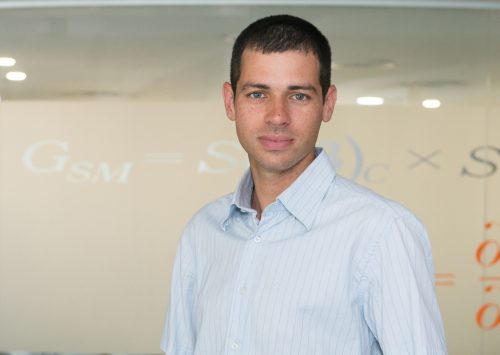Dr. Ofer Furstenberg, who recently joined the faculty of the Department of Physics of Complex Systems at the Weizmann Institute of Science, recently reported on an experiment in which he, together with his research partners, succeeded in causing the formation of photon pairs, a kind of "molecules of light"

Particles of light, photons, do not tend to have too active a social life. A photon detector that measures the light that reaches it, for example, from a laser projector, reports individual light particles, arriving at random times that are independent of each other. But Dr. Ofer Furstenberg, who recently joined the faculty of the Department of Physics of Complex Systems at the Weizmann Institute of Science, reported not long ago on an experiment in which, together with his research partners, he succeeded in causing the formation of photon pairs, a kind of "molecules of light".

The photon pairs were, in fact, created when the laser beam passed through a thin, cold gas, which created a kind of attraction between the photons. That is, the unique properties of this medium meant that in order to reach the lowest possible energy state (to which every particle aspires), photons "should" get closer to each other, and form pairs.
In Dr. Furstenberg's laboratory, at the Weizmann Institute of Science, he plans to build two systems that will produce "molecules of light": one system will have the medium that creates the conditions for the photons to approach each other very cold, while the other system will operate at room temperature.
"Actually," says Dr. Furstenberg, "we launch two beams of laser beams. One beam is relatively powerful, and it creates a kind of tunnel in the gas of the medium. The medium in the tunnel is a billion times more transparent than the medium outside it, and we call this 'electrically induced transparency'. Next comes the weak laser beam, whose photons move slowly through the tunnel (about one millionth the speed of normal light). These photons hit the gas atoms, effectively jiggling their electrons. In this situation, the electrons of the gas atoms move very far from the nucleus of the atom. Atoms in this state are called 'Rydberg atoms', and they are thousands of times larger than atoms at rest."
When a pair of atoms in the medium gas are excited by a pair of photons of the weak laser beam, the oscillating electrons behave as a pair of antennas between which a force acts. These actual forces translate into an attraction between the photons, which causes the photon pairs to form.
This research may shed new light on the properties of light in the quantum world and on the particles of light, photons; For example, how does the effect of the forces between the photons differ from the effect of the actual forces between the particles of matter in nature. "It is possible that in this way we will discover new physical phenomena", adds Dr. Furstenberg. In the meantime, a system like the one he is building in his lab at the institute, capable of creating an "orderly train of photons", can help in efforts to measure gravitational waves through optical measurement.
personal
Dr. Ofer Furstenberg was born and raised in Rishon Lezion. During his military service in the "Talpiot" program, he studied for a bachelor's degree in physics at the Hebrew University of Jerusalem, and then went on to a master's and a master's degree at the Technion. He did his post-doctoral research at Harvard and MIT. In August 2014 he returned to Israel and joined the faculty of the Weizmann Institute of Science.

4 תגובות
Shimon, indeed the speed of light decreases when photons pass through a dense medium (liquids, transparent solids, etc.) - after all, without this effect, a rainbow would not have formed. On the other hand, the researchers report - quote: "Her photons move slowly in the tunnel (about a millionth of the normal speed of light)" - which is a drastic and tremendous decrease in the speed of light. This seems like a mismeasurement to me, because those photons are just too slow.
Another thing: what force holds the photons as a pair? They are not attracted to each other by any of the four forces of nature; And if a pair is possible - why not produce a CLUSTER of tens or thousands of such photons? The scientific and applied implications of such a cluster (many photons moving together as a single body) are endless!!! For example, does a cluster of several photons communicate with each other during their movement? Will manipulating a single photon from such a photon pool change the properties of the other photons next to it? What are the implications for quantum mechanics and relativity?
Joseph
First of all, thank you for the important comment.
Do you have references to studies that describe the phenomena of light passing through a medium of condensed matter?
Thanks.
What is meant by "slowly moving photons"?
Is the speed of light constant?
The article misses an important point. One of the innovations in photons that react strongly together is the introduction of the physics of a condensed matter, and of gas or liquid photons at the same time as ion gas. Anyone who reads the summary of one of the postdoc supervisors at Harvard understands this in half a page. The applications: information transfer, quantum computing, the study of basic phenomena, and more.